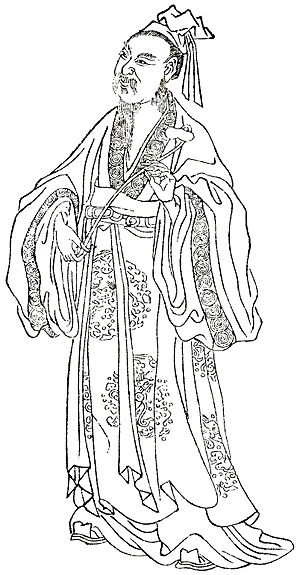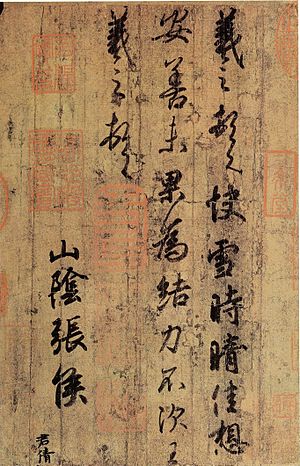Wang Xizhi facts for kids
Quick facts for kids
Wang Xizhi
|
|||||||||||||||||||
|---|---|---|---|---|---|---|---|---|---|---|---|---|---|---|---|---|---|---|---|
| 王羲之 | |||||||||||||||||||

Wang Xizhi
|
|||||||||||||||||||
| Born | 303 or 321 Linyi, Langya, Eastern Jin
|
||||||||||||||||||
| Died | 361 (aged 57–58) 379 (aged 57–58) |
||||||||||||||||||
| Occupation | Writer, calligrapher, politician | ||||||||||||||||||
|
Notable work
|
Preface to the Collection of Poems Composed at the Orchid Pavilion | ||||||||||||||||||
| Children | 7 sons, including Wang Xianzhi & 1 daughter (Wang Mengjiang) | ||||||||||||||||||
| Relatives | Wang Dao (uncle) Wang Qia (younger male cousin) |
||||||||||||||||||
| Chinese name | |||||||||||||||||||
| Chinese | 王羲之 | ||||||||||||||||||
|
|||||||||||||||||||
| Yishao | |||||||||||||||||||
| Chinese | 逸少 | ||||||||||||||||||
|
|||||||||||||||||||
Wang Xizhi (Chinese: 王羲之; 303–361) was a very famous Chinese calligrapher, writer, and politician. He lived during the Jin Dynasty. Many people think Wang Xizhi was the greatest Chinese calligrapher ever. He was amazing at all kinds of Chinese writing styles, especially the running script.
He is also known as one of the Four Talented Calligraphers in China. A powerful emperor named Emperor Taizong of Tang loved his work so much that one of Wang Xizhi's original writings, called Preface to the Poems Composed at the Orchid Pavilion, was said to be buried with the emperor. Wang Xizhi's influence wasn't just in China; he also greatly impacted Japanese calligraphy.
Contents
Life of a Calligraphy Master
Wang Xizhi was born in Linyi, Shandong. His family, the Wang clan, was very important and powerful. When he was about ten years old, there was a lot of trouble in northern China. Because of this, his family moved south. He spent most of his life in places like Shaoxing, Zhejiang and Wenzhou.
Learning Calligraphy
Wang Xizhi learned the art of calligraphy from a skilled teacher named Lady Wei Shuo. He became excellent in every writing style. He was especially good at the semi-cursive script, which is a flowing and artistic way of writing.
Some of his most famous works include Narration on Yue Yi, The Yellow Court Classic, and Preface to the Collection of Poems Composed at the Orchid Pavilion. Sadly, none of his original writings exist today. We only have copies that were made later. You can still see examples of his handwriting in old Chinese calligraphy books.
The Orchid Pavilion Preface
His most famous work is the Preface to the Poems Composed at the Orchid Pavilion. This was an introduction to a collection of poems. These poems were written by many poets during a special gathering. They met at a place called Lanting, near Shaoxing, for a festival.
The original Preface is now lost. However, many excellent copies were made. The earliest and best copy was made around 627-650 AD by Feng Chengsu. This copy is kept in the Palace Museum in Beijing.
The Legend of the Geese
Wang Xizhi had a very interesting hobby: he loved raising geese. There's a famous story that says he learned how to move his wrist while writing by watching how geese moved their necks. He believed their graceful movements held a secret to good calligraphy.
There is even a small porcelain cup that shows Wang Xizhi "walking geese." You can see it in the China Gallery of the Asian Civilisations Museum in Singapore.
His Family and Legacy
Wang Xizhi had seven children, and all of them became notable calligraphers. His youngest son, Wang Xianzhi, was especially talented.
In 2010, a small copy of one of Wang Xizhi's calligraphy scrolls was sold for a huge amount of money. It was a Tang Dynasty reproduction on silk with just four lines of writing. It sold for about $48 million!
Dedication to Calligraphy
Wang Xizhi put a lot of effort into practicing his calligraphy. He used to practice writing near a pond. When he finished, he would wash his brushes and ink-stone in the pond. Over time, the water in the entire pond turned black from the ink! This shows how much he practiced.
There's a saying, "Ru Mu San Fen," which means "penetrating the wood by three parts." This phrase is used to describe very strong and powerful calligraphy. It also means having a deep understanding of something. Once, an emperor asked Wang Xizhi to write some blessing words on a piece of wood. When workers carved the words, they were amazed. Wang Xizhi's handwriting had pressed so hard that the ink went more than a third of the way into the wood! They said his writing was "Ru Mu San Fen."
Mei Zhi Tie
"Mei Zhi Tie" is a famous copy of Wang Xizhi's writing. It has 17 characters and gets its name from the word "meizhi" at the beginning. This work has two lines of writing. It has been shown in important exhibitions, like the "Showa Lanting Memorial Exhibition" in 1973 and the "Chinese and Japanese Calligraphy Treasures Exhibition" in 2006.
Images for kids
See also
 In Spanish: Wang Xizhi para niños
In Spanish: Wang Xizhi para niños




